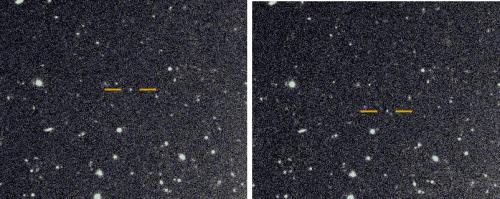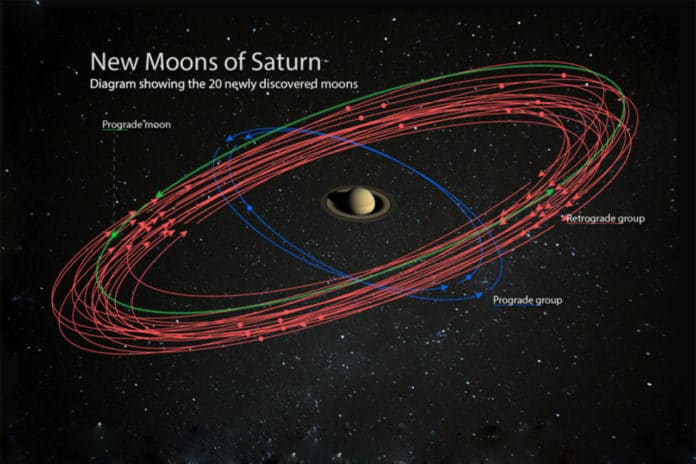Until now, it was known that Saturn has 62 moons of different sizes and compositions, from almost pure ice to rocky material, as well as a combination of both. But, a recent discovery uncovered 20 new moons of Saturn.
Meanwhile, Saturn now has 82 known moons- the discovery that helps the ringed planet surpass Jupiter, which has 79 known moons. Fifty-three moons are confirmed and named, and another 29 moons are awaiting confirmation of discovery and official naming.
The new moons were discovered using the Subaru telescope atop Mauna Kea in Hawaii. Each moon is about five kilometers, or three miles, in diameter. Seventeen of them orbit the planet backward, or in a retrograde direction and other three moons orbit in the prograde—the same direction as Saturn rotates.
Carnegie’s Scott S. Sheppard said, “Studying the orbits of these moons can reveal their origins, as well as information about the conditions surrounding Saturn at the time of its formation.”

These outer moons fall into three categories, based on the angle of their orbit in terms of the inclinations of the angles at which they are orbiting around the planet. Two of the newly discovered prograde moons fit into a group of outer moons with inclinations of about 46 degrees called the Inuit group, as they are named after Inuit mythology. These moons may have once comprised a giant moon that was broken apart in the distant past.
Likewise, the newly announced retrograde moons have similar inclinations to other previously known retrograde Saturnian moons, indicating that they are also likely fragments from a once-larger parent moon that was broken apart. These retrograde moons are in the Norse group, with names coming from Norse mythology. One of the newly discovered retrograde moons is the farthest known moon around Saturn.
Sheppard said, “This kind of grouping of outer moons is also seen around Jupiter, indicating violent collisions occurred between moons in the Saturnian system or with outside objects such as passing asteroids or comets.”
One of the prograde moons has an angle of 36 degrees, which is similar to the other known grouping of inner prograde moons around Saturn called the Gallic group. But this new moon orbits much farther away from Saturn than any of the other prograde moons. This indicates that the moon might have been pulled outwards over time or might not be associated with the more inner grouping of prograde moons.
Sheppard said, “In the Solar System’s youth, the Sun was surrounded by a rotating disk of gas and dust from which the planets were born. It is believed that a similar gas-and-dust disk surrounded Saturn during its formation. The fact that these newly discovered moons were able to continue orbiting Saturn after their parent moons broke apart indicates that these collisions occurred after the planet-formation process was mostly complete and the disks were no longer a factor.”
Last year, scientists discovered 12 new moons orbiting Jupiter, and Carnegie hosted an online contest to name five of them.
Sheppard said, “I was so thrilled with the amount of public engagement over the Jupiter moon-naming contest that we’ve decided to do another one to name these newly discovered Saturnian moons. This time, the moons must be named after giants from Norse, Gallic, or Inuit mythology.”
How to submit the name?
You can tweet your suggested moon name to @SaturnLunacy with the reason behind picking it. Photos, artwork, and videos are strongly encouraged. Don’t forget to include the hashtag #NameSaturnsMoons.
